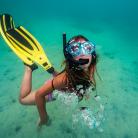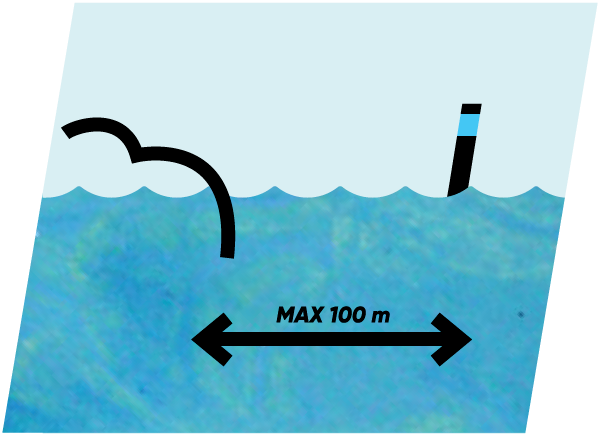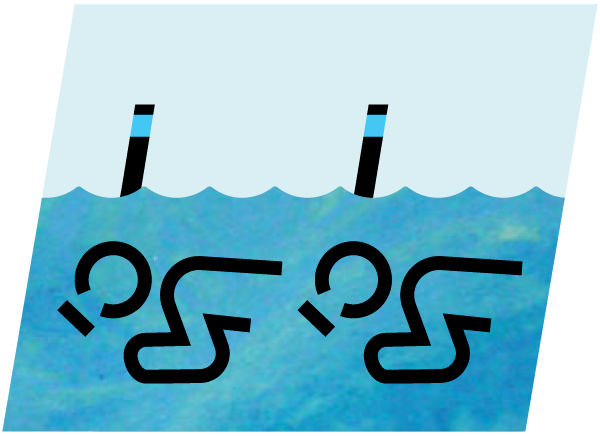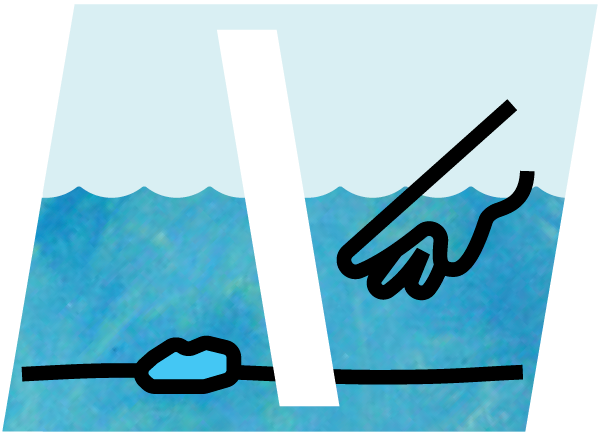Otočić Longa
Longa is an isle in the southern part of the Vrsar archipelago, half a nautical mile away from Porto Sole Camp and Belvedere Resort. Its name – long – stems from its elongated shape although if viewed from the air it looks more like a slipper overgrown with greenery.
The snorkeling location is located on the eastern point, the closest to the land from the north, where two rocks protrude from the sea. No matter how you come to Longa, whether by boat, kayak or sup, the first thing you will notice from a distance is the lush greenery that gives the island its special charm. Large pine trees overhang the maquis and give the impression of a wild Mediterranean forest, while their crowns provide shade even in the shallows.
Curiosities of the sea
The isle of Longa as a snorkeling location hides several interesting features. Both rocks are like islands which can be swum around. The larger rock is lower hiding an underwater arch that you can dive through. The arch is illuminated through three openings at a depth of one metre, one of which is wider and most convenient for the passage of one person. When you emerge from under the arch in the direction of the open sea, you will see on the right side a stone wall that slowly extends deeper. In the gap, at the bottom of the wall, there are schools of damselfish, annual sea breams, two-banded sea breams and the brown wrasse hiding.
By carefully observing the shallow rocks of this cliff, you will notice their velvet-like cover, soft to the touch. On the back side, this rock has a sandy bottom with dunes. At the end of the sand, in the deeper part, there is a small cave passable only for the painted comber and the East Atlantic peacock wrasse, but if you look closely you will see the light at the end of the tunnel.
You can often spot cuttlefish among the underwater mounds. When they see you, they start to change colour and pattern as their way of communicating. They are telling you that they are not interested in getting to know you better, and if you make a sudden move, they will eject "ink" to confuse you and hide their escape route.
Returning to the shallows, the sand slowly turns into small stones with large boulders thrown in. During low tide, the passage around the rock is under one metre deep, but it's worth slipping through as it hides the red-black triplefins. These small fish grow to a length of 7 centimetres, and are easily recognizable by their colour. Males are bright red with a black head, while females and juveniles are lighter, yellowish with a marble pattern. If you approach them slowly and cautiously, you will be able to observe them more carefully. They swim in a zigzag line, and when they spread their dorsal fin, they will amaze you with a beautiful detail - the light blue edge of the dorsal fin. Females have special patterns, depending on the environment in which they live. They are very territorial and do not stray far from their home.
You can also observe various types of combtooth blennies up close, which you will recognize by the extensions on their head, similar to deer antlers. They hide under stones in semi-dark holes. Here you can also find larger turbinate monodonts, while shoals of small fish swarm around the smaller rocks. Not far from the rock there is a small bay coloured with red algae, at the bottom of which a lobster can hide.
A special feature of the Longa location
If you continue to explore this snorkeling location a little deeper, on the sand, in front of a larger rock, some 15 metres away at a depth of 8 metres, you will come across the remains of a fishing trawler that left here an engine with a shaft as a memorial to past work. Today, it is a hiding place for the grouper, the warty crab that carries an orange sponge on its back, and occasional visitors such as lobster or octopus.
The piper gurnard with its small legs often walks on the surrounding sand. If you startle it, it will spread its pectoral fins like wings featuring a turquoise edge and blue dots.
A frequent guest during July is also the common eagle ray, which can be seen in small groups resting on the sand. If you approach them slowly you will be able to enjoy their flying which looks like floating above the bottom, amazing!
Safety comes first
When diving through the underwater arch, pay attention to the size of the passage and the necessary depth for a safe exit. Too shallow a dive would result in a scratched back.
During summer months, Longa is a favourite place to escape from the hustle and bustle of the city beaches. Be careful when moving away from the rocks and always observe the situation at sea; if someone is dropping anchor or just passing by the island...
Do not swim to the nearby islet of Galopun because there is a waterway between.
Our relationship with the sea
At the Longa snorkeling location, you can find the remains of shipwrecks scattered everywhere, but do not take them out of the sea, nor touch them. They are just a reminder of the unpredictable nature of the sea, which must be respected even when choosing the moment to go snorkeling. The most pleasant snorkeling is during calm seas.











